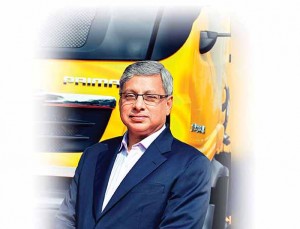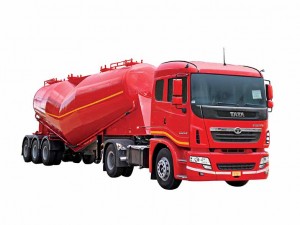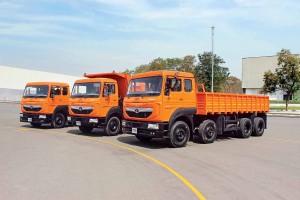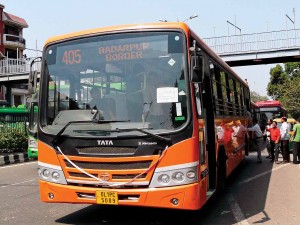Post the transition to BSIV, Tata Motors is eyeing strong growth.
Story by:
Bhushan Mhapralkar
Like many other commercial vehicle manufacturers, demonetisation affected Tata Motors too. The end of FY2016-17 marked not just the end of a tumultuous period, it also marked green shoots. For example, buses did exceedingly well. For Tata Motors, they posted a growth of 22 per cent against an industry growth rate of 10 per cent. This led the company to grab the lead in the Indian bus market. LCVs also performed well for Tata Motors. Looking at a new period that does not come often, and will perhaps never come again, Tata Motors is looking up to an exciting future. According to Ravi Pisharody, Executive Director – Commercial Vehicles, Tata Motors, the CV maker is confident of infrastructure revival helping it to grow. It is also looking at growth coming from the push for electric and alternate fuel vehicles. With teams in place, and post the significant structural changes to assume a leaner form, the company is exerting a good deal of thrust on exports as well.
The Ultra, according to Pisharody, is in the sweet spot. It is helping the company, along with the Prima, to drive exports. Export volume accounts for 17 to 18 per cent of the total volume, and is expected to go up to 25 per cent. Keen to offer the lowest cost of ownership, Tata Motors, in FY2016-17, saw the M&HCV segment shake and rattle. A segment where its new age products, Signa and Prima, enjoy a considerable clout. The months of April and May brought good growth to M&HCVs whereas the months of June, July and August proved to be weak. The reason, said Pisharody, could be attributed to GST. “GST started doing the rounds, and the PMO and the finance minister began talking about its implementation from April 2017. This seems to have led to lacklustre performance of M&HCVs in June, July and August last fiscal on the back of uncertainty, as CV buyers, hoping that prices will fall, decided to postpone their purchase. The talk of a tax structure of 18 per cent would entail a drop in prices by 8 to 10 per cent,” he expressed. The M&HCV segment started gaining velocity in September, and because of the good monsoon. In October 2016, and at the start of the festive season, the M&HCV segment recorded the highest growth in FY2016-17.
Demonetisation
In November 2016, the effect of demonetisation was most felt in north and west, the markets where Tata Motors enjoyed the most exposure. “For a few days, the CV industry was literally stranded on the road,” opined Pisharody. Pointing at the way the transport industry works, Pisharody said, “A truck driver carries an amount of cash, which the driver and owner figure out as necessary.” The industry declined over the next two months. Tata Motors’ sales declined 30 per cent in comparison to October, and 15 per cent in comparison to the corresponding month of the previous financial year. The same situation prevailed in December 2016. In January 2017, the effect had vanned.
Despite the Environmental Pollution (Prevention and Control) Authority for Delhi & NCR (EPCA) exerting its stance, it was expected that February, March and April 2017 would witness pre buying. An amount of pre-buying did take place. Tata Motors however, took a balanced approach according to Pisharody. This ensured that the CV maker did not carry much inventory into March 2017. “We looked at precedence, when vehicle manufacturers were allowed to sell their existing stock, and not manufacture it after the cut-off date. The Supreme Court judgement was surprising,” expressed Pisharody. He said further, “Our strategy works around dealers carrying a stock of 30,000, all segments included, at the end of March. It amounts to one month of stock, and something which the dealer is able to carry into the next month. In this case, into April.” Production of BSIII CVs was immediately cut down on March 29, 2017, by Tata Motors. More impetus was laid on BSIV vehicle production, which the company was already ramping-up. Attention was also paid to help dealers to liquidate their stock.
What made it important to help the dealers liquidate their stock was the sales tax component already paid. Taking back dealer stock would have meant losing the paid tax component. “We were largely successful in liquidating the dealer stock,” stated Pisharody. Over a off-take and retail of 30,000 in February 2017, the March 2017 off-take was only 36,000. Tata Motors did not push inventory, and the figure the company settled for in March 2017 was lower than March 2016. In March 2017, the company witnessed solid retails of between 51,000 and 52,000. Dealer stock of BSIII vehicles according to Pisharody was very low as a result. It was between 3000 and 4000. Big trucks amounted to less than 500. At the plant level, the company incurred a stock of 15000 CVs.
Getting rid of the inventory
To get rid of 15000 BSIII CVs, Tata Motors is looking at export markets. It is also looking at aggregates to be sold as spares. Putting the company at a disadvantage when it comes to market share in March, Tata Motors reported a wholesale volume of 14000 as compared to a retail volume of 22,000-23,000. Out of the 15000 BSIII CVs left with Tata Motors, the number of M&HCVs, according to Pisharody, is 4000 units. He informed that discussions are on to seek a legal remedy, and that the government is supportive. Upon analysing, Tata Motors found out that 8000-8500 units (out of the 15000 BSIII vehicles) could be exported to markets like Sri Lanka, Nepal and Bangladesh as they are. Considering a monthly export of 5000 to 5500, it would take the company four to six months to get rid of the BSIII stock opined Pisharody. Of the remaining vehicles (that are not exported), Tata Motors plans to convert to BSIV. An ICV like the Tata 1109, explained Pisharody, can be converted to BSIV with a nominal cost of five per cent. Conversion of such vehicles has already begun. In case of vehicles that would pose a conversion challenge in terms of efforts and expense, Tata Motors is moving slowly. While hoping that a legal remedy is available to dispose them, the company is also looking at cannibalising high value items like gearbox, tyres, etc. This would help it to fulfill its long-term service obligations.
Beginning of a new period
Tata Motors is looking at FY2017-18 as a completely new period. The product performance equation in comparison to the competition will change according to Pisharody. The price positioning as well as customer eligibility will also change, said Pisharody. Terming the company as a CV market leader, and futuristic in its approach, Pisharody averred, “We will cater to price conscious as well as performance conscious customers.” The company will bank on a dual strategy as the new period reveals itself. For lower powered engine of up to 160 and 180 hp, the company is looking at EGR. With an overlap between 160 hp and 180 hp, Tata Motors is looking at deploying SCR technology on higher powered CVs. “All Tata engines have EGR,” informed Pisharody. He said, “Look at the 497 engine for example, and it is equipped with an EGR. The new three and five-litre engines that power the Ultra will deploy EGR. Two-axle trucks and lower powered buses will be equipped with EGR technology. For muti-axle heavier trucks, SCR technology will be deployed.”
If the stress on SCR technology hints at an attention to BSVI emission norms, Tata Motors is making a big jump in technology. It is doing so with an intention to achieve benefits like fuel economy, reliability and lower maintenance costs. Pisharody may expect higher resale value to come in once the migration to new (BSIV) technology takes place, and on the back of fuel, which will be different from what was available until now, the fact is, the next quarter looks lacklustre. It is something that Pisharody is well aware of. Especially on the back of some pre-buying in February and March. With GST scheduled for July 01, 2017, an amount of uncertainty is expected. Uncertainty is expected go down in the second quarter of FY2017-18 according to Pisharody. He opined that bus and SCV sales in July and August are expected to be much better than they were during the corresponding period last fiscal. Buses, he quipped, are already on SCR. As 13 Indian cities moved up to BSIV emission norms in 2010, Tata Motors equipped buses and urban application CVs like garbage compactors (on 1621 platform) with SCR technology. SCR technology for Tata Motors is therefore not newfound.
EGR vs SCR
Ramping up production of BSIV CVs, the company has limited the deployment of SCR tech to Tata Cummins engines. The four-cylinder engines that Tata makes, will continue to be equipped with EGR. With Cummins, said Pisharody, Tata Motors is enjoying access to the latest and the most modern technology. Apart from SCR equipped engines, Tata Motors will also source EGR equipped engines from Tata Cummins in the 150 to 200 hp power range. Confident of the GST elevating the efficiency of the logistics industry (by doing away with border checks), Pisharody opined, “The strategy is to equip a certain range of engines with EGR, and a certain range of engines with SCR.” Girish Wagh, Head – Project Planning & Programme Management, M&HCV, Tata Motors, explained that they have acquired good global and local experience from the use of EGR and SCR technology. “For light-duty applications of up to 150 and 160 hp, EGR can do the job, and would entail lower costs,” he mentioned. SCR technology, according to Girish, makes sense for engines that are powerful as it will provide better fuel economy. “Beyond 180 hp, liquid economy of SCR is better than EGR”. With the use of SCR engines, Tata Motors is eyeing the twin advantage of lowest cost of operation and longer engine life. Well aware that the move to BSVI emission norms will make SCR essential, BSIV trucks with SCR techlogy according to Pisharody will command good resale value.
With the engine governed electronically, Tata Motors has had an opportunity to add value. It thus developed vehicle acceleration management system that filters driver input to ensure optimum efficiency and longer aggregate life. Tata Motors has also developed fuel economy switch, the mode of which the driver can select depending upon the duty cycle and usage condition. A host of technologies have been developed by Tata Motors to increase aggregate life. Efforts to improve ride and comfort were undertaken on the basis of the feedback received. The company has developed a modular chassis frame, which aligns with multiple applications. A new 6.5-tonne front axle has been developed to facilitate higher load carrying capability. Revealed Girish that 14000 common-rail trucks are already plying in India for the last seven years, and have provided a good learning opportunity. The company, averred Girish, is deploying 1800-2000 bar pressure common-rail systems and DOC for EGR application. The price differential between BSIII and BSIV Tata CVs is in the region of 10 per cent. For the higher amount paid, the operator is getting much better value mentioned Pisharody. He said, “We are offering better AMC for SCR equipped vehicles.” Keen to ensure that Tata CV operators enjoy lower total cost of ownership, the company will market AdBlue solution as a Tata brand through 3000 outlets and fuel stations.
Confident of infra revival, and the rising demand for electric vehicles (a tender for 100 electric-buses has been floated at Pune, and for at least six buses in Himachal Pradesh), Tata Motors, expressed Pisharody, is expecting new regulations like AC, advanced crash norms and CAFE to call for attention in the next two years. “Powertrain and vehicle teams at Tata Motors are in place for BSVI regulations that are due to come in force by 2020,” Pisharody signed off.































